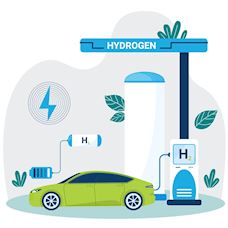
Navigating the rise of technology in construction
In this article we’ll dive into the booming world of smart construction technology, exploring the innovations driving the change and what the future looks like for the industry.
Demand generation has been around a while but overlaps with so many other marketing processes that there's often confusion about what it is. In fact, demand generation is exactly what it says – it's about generating demand for your product or service. The reason why demand generation is important is because often prospects are not necessarily aware of a need or a problem, or a better way of doing things. And that means that they're not seeking a solution or a new vendor.
Demand generation is therefore about raising awareness of certain issues and challenges that you can help resolve through your product offering or capabilities – revealing a need that people didn't know they had. It's about relating to their lives and highlighting the limitations of the status quo so that your prospects start to think 'Yes, I can see that might be a problem... I wonder if there's something out there that would overcome it?' So it's not the same as lead generation but it is an essential part of the process – you need to generate demand before you stand a chance of generating any leads.
Let's look at some real life examples. Demand generation has worked well for us where we've needed to suggest to an audience that there was a problem with their normal choices. For instance, a few years ago, the frequent choice for organisations with fleet cars was to choose diesel vehicles – this was the choice that offered lower fuel costs and that was expressly encouraged by the Government. On behalf of Toyota & Lexus Fleet, we created a campaign that encouraged organisations to 'Quit Smoking' and choose hybrid vehicles instead, so benefiting from superior whole life costs and a reduced impact on air quality.
Another example is the campaign we created for Bosch Professional to generate demand for their wireless charging tools. At the time, tradespeople had to carry round multiple batteries to make sure that their cordless tools didn't run out of charge during the middle of a job. We created an issues-based campaign around 'charge anxiety' (the need that tradespeople didn't know they had until we pointed it out), suggesting that there was a better way forward than carrying multiple batteries – namely, wireless charging!
Once you've sparked an initial curiosity or awareness of need in your prospects, you then need to fuel further interest, keeping front of mind and making sure you can withstand substantial scrutiny vs competitor offerings. Obviously, one fleeting spark of interest isn’t going to give you your prospects' contact details and certainly not their business straightaway. Instead, you have to nurture your prospects, engaging them across the whole marketing mix through multiple channels so that they keep bumping into you.
So why is demand generation currently so talked about? Well, there are two key reasons:
As we all know thanks to Forester's much-quoted stat, buyers make 67% of their purchasing journey digitally – self-educating and navigating to solutions and providers. And this means that it's imperative to share persuasive content online, becoming an active and trusted source of information to steer prospects your way.
Let's now look at the specifics of demand generation. How do you get started?
Demand generation – in five easy steps
1. Develop a strong proposition
To stay ahead, progressive companies are developing product initiatives way ahead of market demand – initiatives driven by the bright ideas of their R&D future thinkers. This means that your prospects don't know or understand the benefits of new solutions – in the same way that, before the motor vehicle was invented, people wouldn't have understood the benefits of anything other than a faster horse! This makes life hard for your sales and marketing team as they have to build an understanding and appreciation of the offering in the market from scratch.
For example, to create an understanding of connected tools, we developed a creative campaign for Bosch Professional with a key visual that showed the evolution of working people and their tools – from ‘Neandertool’ to ‘Millennitool’. This gave prospects the vision of an enhanced, more connected future, suggesting that connected tools were the way forward for those who wanted to be part of this future.
Many product initiatives involve more gradual improvements, but you still need to develop a strong proposition that makes it clear why your product or service is better than a competitor’s. Prospects do their homework and will often know if there's not much to differentiate your product from that of another provider. Often it is about creating a preference for your company, service, ethos or culture. Online infotainment and likeability can go a long way here.
2. Plan your audiences and content journeys
In B2B there are many different influencers involved in decisions so you need to generate relevant online content to reach these different audiences. Map out your audience personas, their needs and wants, and use this knowledge to shape and tailor your content.
Once you've highlighted the limitations with the status quo and awakened interest in a better way forward, think about what you can offer next to build enthusiasm and maintain interest. For example, maybe you could provide your prospects with the appropriate rationale to persuade others in their organisation to support the investment. Remember, everything that a good salesman would traditionally have covered face-to-face, now needs to happen online.
3. Create great content
Demand generation relies heavily on good content creation – something many businesses fail to budget for sufficiently. Creativity and quality are vital. It’s not quantity that counts, it’s the positive impression that your content creates – that all-important ‘likeability’ for your organisation.
You could provide a free tool to demonstrate the benefits of your offering, or make a real life or animated video that tells the story in a more compelling and interesting way. Webinars are relatively easy to set up, but first think through why someone should sit through one. Perhaps you could partner with a well-known guest (so increasing your standing by association) or include users to add peer-to-peer credibility.
Giving away your know-how will reflect well on your brand, build trust and advocates, and get you talked about. Don't worry about revealing stuff to your competitors – they probably already know it anyway! The winner these days is the one who shares most freely externally to win hearts and minds of potential prospects and employees.
4. Publicise and repurpose content across various channels
Once you have developed your value proposition and mapped out your main story and content journey plan, next you need to plan roll-out across the various channels. There's a vast array of opportunities, so start with the channels that will help you reach the greatest numbers of prospects, doing only what is manageable to do well.
5. Progressive data collection
Demand generation is a forerunner to building a database that you can use for lead generation. As you generate demand, you should be able to gather some data on interested parties along the way – and it’s important to do so, so long as you observe GDPR guidelines.
For example, when a prospect views a piece of content, you could ask them to opt in for a second item and /or for specified types of content pieces or topics. This way they understand why they are giving you their details and you are able to send them another compelling piece of content that continues to nurture their interest. Thereafter, each time they engage, you can ask for another data item such as their role, responsibility or area of interest, so long as you are transparent in why you need it, what you will use it for, why it’s in their interest to share that with you, how long you’ll keep it and how their rights work for sight of it and updates etc. These are the types of aspects GDPR means you must consider.
Depending on what you’ve promised them – you can use this information to tailor subsequent content. For instance giving examples of the issues being resolved within their specific industry, or to provide details on the issue from the perspective of their particular role, e.g. highlighting the commercial issues for FDs or C-suite directors.
Many B2B companies lack understanding of the data they hold and GDPR now means it’s imperative to do an audit of what you hold, know how it was/is collected, ensure updates and permissions are clear with context from each and every individual.
However, for many B2B businesses, it’s not about needing millions of contacts, leads or conversions, it’s about being seen in the right light by a few, touching a nerve that leaves an impression – and then remaining front of mind so you are turned to first when the time is right.
Summing it all up
To sum up, demand generation is an important first stage of your journey to find leads. It's usually most effective if you can reveal an issue or limitation with the status quo to your potential prospects and then show how this could be addressed. At this stage, don't focus on your particular product, services or solution. What you're doing here is building credibility, not selling. Once you’ve developed your value proposition in this way, communicate it across as few or as many platforms as you can manage well. As you build your data and your knowledge of followers and contacts, plan content for different user journeys, directing prospects to content that's relevant for them. Don’t skimp on the creativity and quality of the messaging. Good demand generation depends on making a great impression – it's not about a mass of poorly-executed coverage.
Finally, be patient – there’s no such thing as a quick fix. Even with a marketing automation platform the process is not quick nor automatic (don’t even get me started on this). But once you have a demand generation strategy in place, it will gather momentum and effectiveness, gradually luring your prospects into a lead-generating funnel.


In this article we’ll dive into the booming world of smart construction technology, exploring the innovations driving the change and what the future looks like for the industry.

Learn how to use presentation opportunities as an effective lead-generation tool in your trade show activity.

Great marketing success comes from keeping your communications focused, engaging and simple to ‘get’ - but that isn’t always so simple to achieve.

With multiple types of technologies being considered, we bring you a snapshot of alternative fuels and review the most prominent pros and cons for each one.